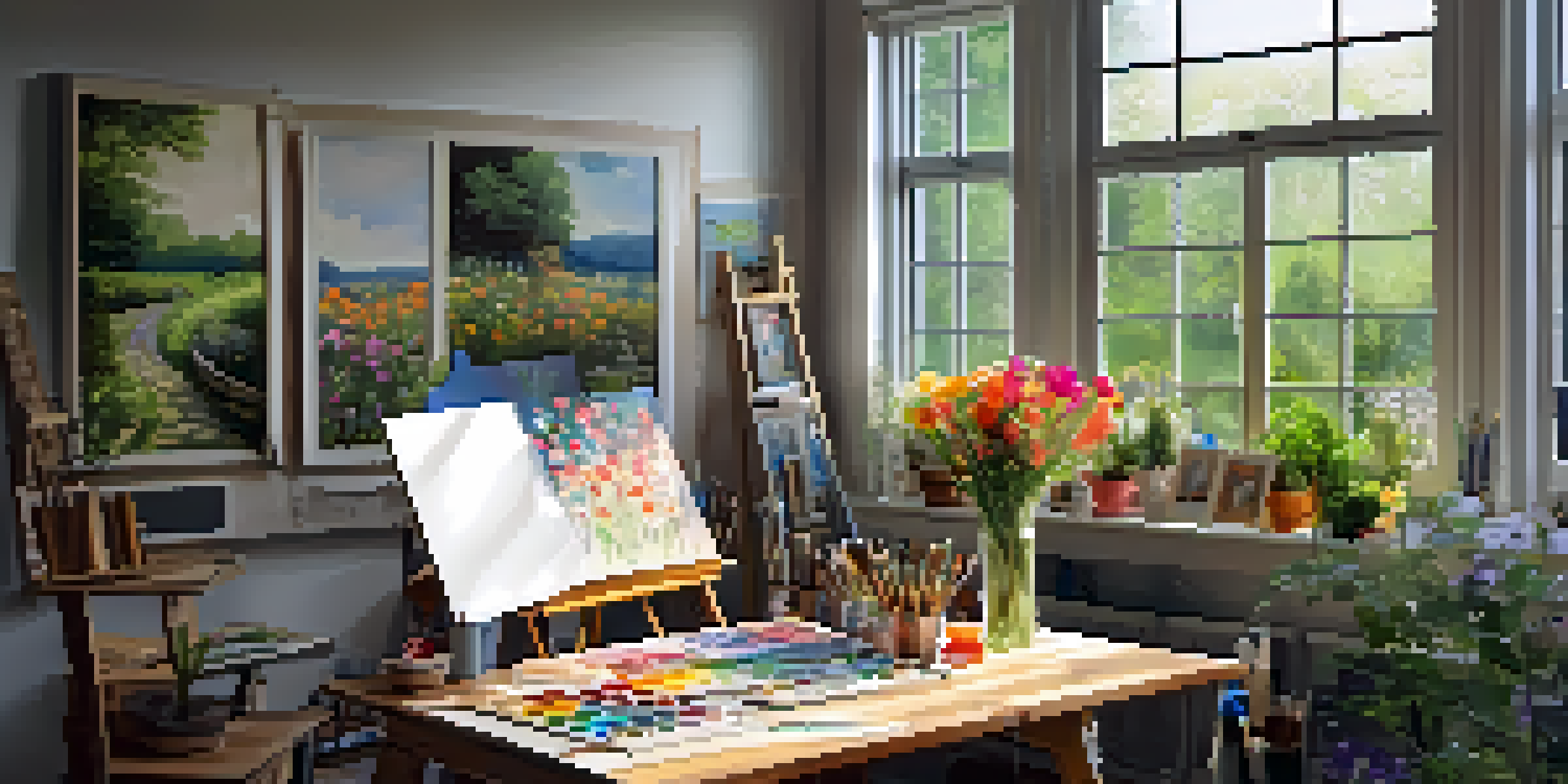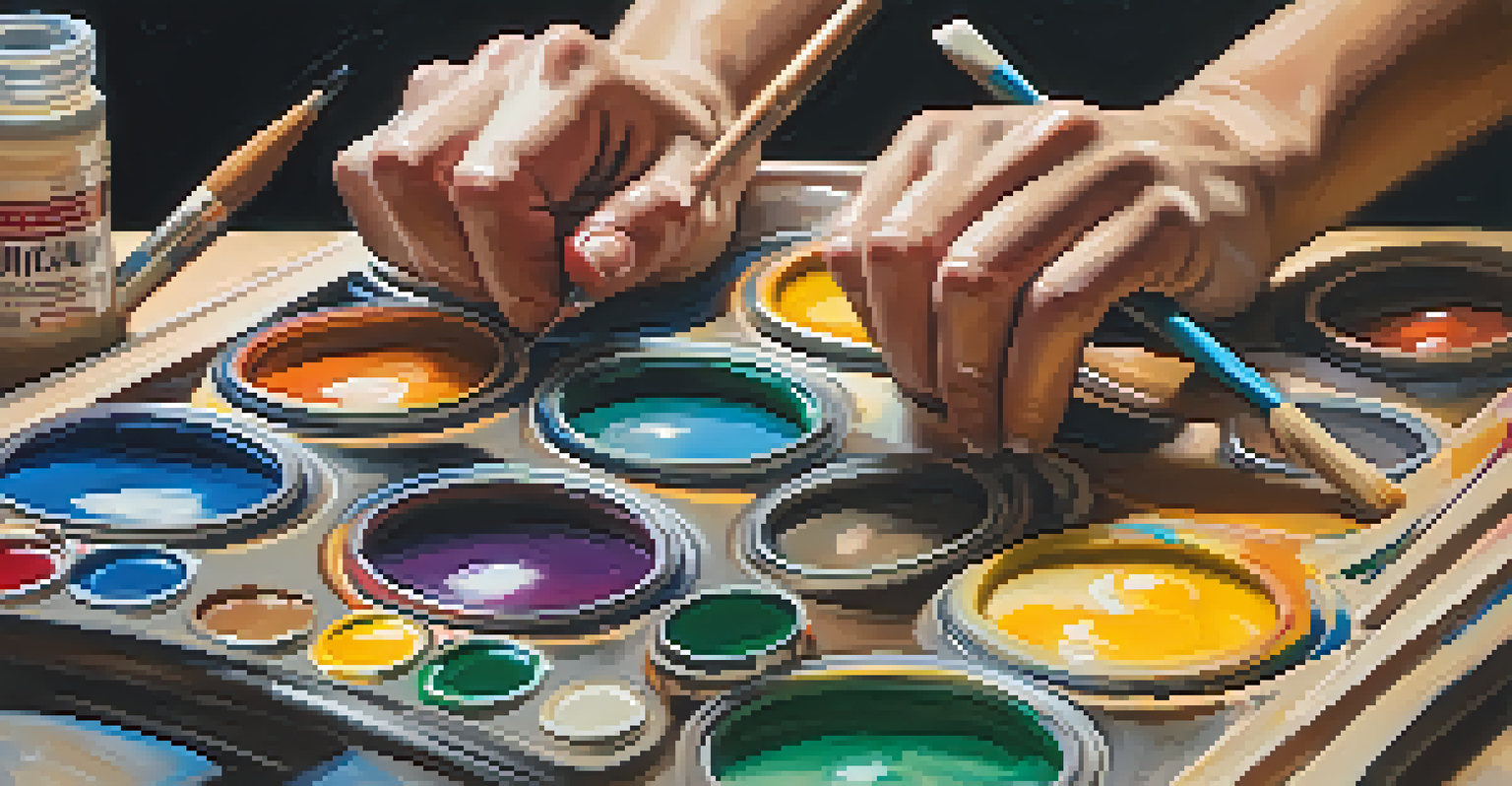Strategies for Teaching Acrylic Painting to Beginners

Understanding the Basics of Acrylic Painting
Before diving into acrylic painting, it's essential to cover the basics. This includes understanding the properties of acrylic paint, which is fast-drying and versatile. Beginners should learn about the different types of brushes, canvases, and palettes available, as these tools will greatly influence their painting experience.
Every artist was first an amateur.
Incorporating simple demonstrations can help clarify these concepts. For instance, show how acrylics can be diluted with water for a watercolor effect or layered for a more textured finish. By visualizing these techniques, students can grasp how to manipulate their materials effectively.
Providing clear, relatable examples—like comparing acrylic paint to other mediums like oil or watercolor—can further enhance understanding. This foundational knowledge sets the stage for more complex techniques and ensures that beginners feel confident as they start their painting journey.
Creating a Comfortable Learning Environment
A welcoming atmosphere plays a crucial role in teaching art. Make sure your classroom is well-lit, organized, and filled with inspiring artwork to ignite creativity. Comfortable seating and access to supplies can also help students focus on their art rather than their surroundings.

Encouraging open communication is another vital aspect. Allowing students to express their concerns or ask questions creates a sense of community. This supportive environment helps alleviate the fear of making mistakes, which is essential in any creative process.
Master Acrylic Basics First
Understanding the properties of acrylic paint and the essential tools helps beginners feel more confident as they start their painting journey.
Incorporating music or other calming elements can also enhance the painting experience. Just like a cozy café can make a cup of coffee taste better, a relaxed environment can inspire creativity and make learning acrylic painting more enjoyable.
Starting with Simple Projects
Beginner artists often feel overwhelmed by the vast possibilities of acrylic painting. Starting with simple projects, such as painting basic shapes or landscapes, can help build confidence. These manageable tasks provide a sense of accomplishment and encourage experimentation without the pressure of perfection.
Art is not freedom from discipline, but disciplined freedom.
Using templates or guided exercises can also be beneficial. For example, a 'paint along' session where everyone recreates the same image can foster camaraderie and allow beginners to learn from one another. This collaborative effort can turn an intimidating experience into a fun group activity.
As students gain confidence, gradually introduce more complex projects. This step-by-step approach allows them to build on their skills and encourages them to explore their unique artistic styles as they progress.
Teaching Color Theory Basics
Color theory is a fundamental concept that can elevate any painting. Teaching beginners about primary, secondary, and complementary colors is essential for creating vibrant artwork. Use a color wheel to visually demonstrate these relationships, making it easier for students to understand how colors interact.
Encourage students to experiment with mixing colors to create their own palettes. This hands-on approach not only reinforces color theory but also fosters a sense of ownership over their work. By seeing how colors blend and change, beginners can develop their intuition for color selection.
Foster Individual Expression
Encouraging students to explore their unique styles and subjects enhances their creativity and investment in their artwork.
Incorporating exercises like creating a monochromatic painting can further deepen their understanding. Such projects allow students to focus on value and shading while becoming comfortable with color application in a less overwhelming context.
Demonstrating Techniques Step-by-Step
Demonstrating techniques in a clear, step-by-step manner is crucial for beginners. Whether it's showing how to create texture with a palette knife or layering colors for depth, breaking down each technique makes it more accessible. Visual learners will particularly benefit from this approach, as they can see the process unfold.
Encourage students to follow along as you demonstrate. This hands-on practice reinforces what they've just learned and allows for immediate application. Providing constructive feedback during these sessions can also help reinforce good habits and correct mistakes early on.
Additionally, consider filming or photographing your demonstrations. This way, students can revisit the techniques at their own pace, further solidifying their understanding and skill set as they practice outside the classroom.
Encouraging Individual Expression
While guidance is essential, encouraging individual expression is equally important in art. Allowing students to choose their subjects or styles can lead to a more personal and enjoyable painting experience. When learners feel free to explore their creativity, they are more likely to invest themselves in their work.
Introduce different styles of acrylic painting, such as abstract or realism, to spark inspiration. Discussing famous artists and their unique approaches can also motivate students to find their own voice. By showcasing a variety of styles, you can help them see that there’s no single right way to paint.
Provide Constructive Feedback
Offering specific and supportive critiques helps students recognize their strengths and areas for improvement, fostering growth and community.
Regularly providing opportunities for students to share their work fosters a supportive community. When they see the diverse interpretations of the same techniques, it reinforces the idea that art is subjective and personal, encouraging them to embrace their individuality.
Providing Constructive Feedback
Feedback is a vital part of the learning process, especially in art. Providing constructive critiques can help students identify areas for improvement while also acknowledging their strengths. Aim to be specific in your feedback, focusing on techniques, color choices, and composition to guide their growth effectively.
Encouraging peer feedback can also enhance the learning experience. When students share their work with each other, they learn to articulate their thoughts and appreciate diverse perspectives. This collaborative environment not only builds confidence but also fosters a sense of community among budding artists.

Remember to celebrate progress, no matter how small. Recognizing achievements, such as mastering a difficult technique, boosts morale and motivates students to continue exploring and improving their skills.
Inspiring Continued Exploration Beyond Classes
Teaching acrylic painting to beginners shouldn’t end in the classroom. Inspire students to continue exploring their creativity outside of lessons by providing resources such as books, online tutorials, or local art fairs. Sharing relevant articles or videos can spark their interest and provide additional learning opportunities.
Encourage them to join local art groups or online communities where they can share their work and get inspired by others. Being part of a larger artistic network can keep their passion alive and provide valuable feedback as they grow as artists.
Lastly, remind them that art is a journey, not a destination. By fostering a lifelong love for painting and creativity, you empower them to embrace their artistic pursuits, whether as a hobby or a potential career.